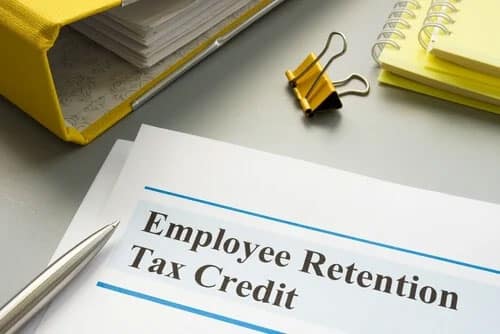BLOGS
Employee Retention Credit (ERC) Frequently Asked Questions

Please review the ERC questions below to learn more about the IRS Employee Retention Credit for your business. If you have additional questions about ERC or need help filing for the credit, we have extensive ERC experience. Learn how to file ERC. Check out the ERC questions and ERC credit requirements below. File for ERC credit 2022.
1. What is an Employee Retention Credit?
An Employee Retention Credit is a refundable payroll tax credit created by the CARES Act. ERC can be as high as $26K per employee.
2. Is the Employee Retention Tax Credit a Loan I Have to Pay Back?
No, the Employee Retention Credit is exactly what it reads, a credit! ERC is essentially a refund from the IRS that you claim against specific employment taxes. The refund is a credit in excess of your payroll taxes applied to credit-generating periods. ERC is not considered a loan, and will not have to be paid back.
3. Can my business qualify for an Employee Retention Credit and a Payroll Protection Program (PPP) Loan?
Your business can be eligible for both PPP and ERC. If you are to receive both, specific wages used to compute PPP loans cannot be used when calculating your ERC.
4. What is the Difference Between ERC and ERTC?
Both are abbreviations for Employee Retention Credit or Employee Retention Tax Credit. Either abbreviation is correct and apply to the same program, Employer Retention Tax Credits.
5. How do I Apply for an Employee Retention Tax Credit?
You must first determine if you qualify and for what time periods in 2020 and 2021. There is no ERC application process. You must file an amended 941, form 941-X, for each quarter your business is eligible to claim the credit.
6. Does the number of Full Time Employees I have Effect My Ability to Claim Employee Retention Credit?
For 2020 ERC, only businesses with up to 100 full time employees in 2019 are eligible.
For 2021 ERC, the maximum number of full time employees in 2019 cannot exceed 500.
7. What are the requirements to become eligible for an Employee Retention Credit?
If your business experienced a partial shutdown due to government pandemic-related orders limiting commerce, meetings, travel, or had significant reductions in quarterly gross income (≥50% for quarters in 2020 and ≥20% for quarters in 2021) compared to the same quarters in 2019, you qualify for ERC.
ERC for self employed is unfortunately not available but the government created a very similar tax credit (COVID tax credits) for people who work for themselves.
8. Should I use the Government Mandate Test or Gross Receipts Test to Determine ERC Eligibility?
Determining your ERC eligibility only has to be via one of these methods and not both. In fact, the method could also vary by quarter. Businesses that started after February 15, 2020 could also be eligible for ERC for the third and fourth quarters of 2021 as a Recovery Startup Business.
9. How do I Claim ERC as a Recovery Startup Business?
To qualify as a Recovery Startup Business, the business must have begun carrying on trade or business after Feb. 15, 2020 and:
- Have annual gross receipts that do not exceed $1 million
- Not be eligible for the ERC under the other two categories, partial/full suspension of operations or decline in gross receipts
- This factor can only be used to claim ERC in Q3 and Q4 of 2021 and is capped at $50,000 per quarter
10. Is it too Late to Claim my Employee Retention Credit?
Businesses have up to three years from when the original Federal Quarterly Employment Tax Return, Form 941, was filed to claim ERC. The IRS considers 941s filed on April 15 of the following year the returns are related to. All 2020 941s would be considered filed on April 15, 2021, providing until April 15, 2024 to claim ERC. All 2021 941s would be considered filed on April 15, 2022, providing until April 15, 2025 to claim ERC.
11. What are the Specific Years and Time Frames for Employee Retention Credits?
For the calendar year 2020, ERC can be claimed for wages paid after March 12, 2020 through December 31, 2020. In 2021, ERC can be claimed for wages paid January 1, 2021 through September 30, 2021 (Recovery Startup Businesses can claim ERC on wages through Dec. 31, 2021).
12. Can I Only Claim the Employee Retention Credit for Full-Time Employees?
Both part-time and full-time employee wages qualify for your ERC calculations.
13. Should I Complete my PPP Loan Forgiveness Prior to Filing for my Employee Retention Credit?
You do not have to complete your PPP loan forgiveness prior to filing for ERC. PPP loan funds used on wages do factor into your business's unique ERC calculation. You should allocate the maximum allowable non-payroll related expenses to the PPP loan being forgiven.
14. How Long Does it take to Receive the Funds from the IRS for my Employee Retention Credit?
Their are many factors that play into the amount of time it will take to receive your check for ERC credit from the IRS. It can take up-to one year to receive your refund checks from the time you filed your 941X amended payroll tax return.
15. Should I have my Payroll Company Analyze, Prepare and File my Employee Retention Credit?
Not all payroll companies offer tax credit service but if they do, they can be a good choice because they have access to all your payroll data and are experts in filing payroll tax returns including the 941-X.
16. Do Independent Contractors (1099s) Qualify as Employees for the Employee Retention Credit?
Independent contractors (1099) and the compensation paid to these individuals are not eligible for ERC and shouldn’t be included in your qualified wage calculations.
17. What are the Inclusions and Exclusions from Gross Receipts for the Employee Retention Credit?
Your PPP loans and ERCs should be excluded. Gross receipts, total sales, net returns and allowances, and amounts received for services should be included. Additionally, you will need to add any income from investments, and from incidental/outside sources—regardless of whether you included this income in your gross income.
18. Are Forgiven PPP Loans Counted as Gross Receipts for Employee Retention Credit Calculations?
IRS Safe Harbor guidance issued in August 2021 states PPP loan forgiveness doesn’t create gross receipts equal to the forgiveness and also applies to Shuttered Venue Grants and Restaurant Revitalization funding.
19. Are Non-Profit Businesses, 501(c)(3), Eligible for the Employee Retention Credit?
Non-profit businesses can be eligible for ERC, although generally exempt from income taxes, they still pay employment taxes on wages paid to their employees.
20. If We use a PEO, Can We Still be Eligible for the Employee Retention Credit?
Yes, businesses that use a PEO and meet the eligibility rules for ERC, can claim the credit.
21. Are Religious Organizations and Churches Eligible for the Employee Retention Credit?
Churches and other religious organizations impacted by government-ordered capacity restrictions, or that experienced significant reductions in gross receipts are likely eligible for ERC.
21. Can you still file for ERC credit 2022?
The simple answer to that question is ,yes you can still file for ERC credit 2022. Claim ERC tax credit 2022 today.
DISCLAIMER: The information provided herein does not constitute the provision of legal advice, tax advice, accounting services or professional consulting of any kind. The information provided herein should not be used as a substitute for consultation with professional legal, tax, accounting, or other professional advisers. Before making any decision or taking any action, you should consult a professional adviser who has been provided with all pertinent facts relevant to your particular situation and for your particular state(s) of operation.







